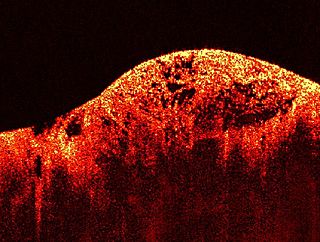Sarcoma facts for kids
Quick facts for kids Sarcoma |
|
|---|---|

Optical coherence tomography (OCT) image of a sarcoma
|
|
| Classification and external resources | |
| Synonyms | Sarcomas, sarcomata |
| Specialty | Oncology |
| Patient UK | Sarcoma |
A sarcoma is a type of cancer. Cancer happens when some cells in the body start to grow out of control. These cells can then form a lump or mass. Sarcomas specifically come from cells that make up your connective tissue.
Connective tissue is like the "glue" that holds your body together. It includes things like bone, cartilage, fat, and blood vessels. Because sarcomas can start in any of these tissues, there are many different kinds. The word "sarcoma" comes from the Greek word sarx, which means "flesh."
Contents
What is Sarcoma?
Your body is made of tiny building blocks called cells. Normally, cells grow, divide, and die in a controlled way. This process helps your body stay healthy. Sometimes, however, cells can change and start to grow without stopping. When this happens, it can lead to cancer.
Sarcomas are different from other common cancers. For example, most cancers start in organs like the lungs or skin. Sarcomas begin in the body's connective tissues. These tissues support and connect other parts of your body.
Types of Sarcoma
There are over 70 different types of sarcomas. They are grouped based on the kind of tissue they start in. For example, a sarcoma that starts in bone is called an osteosarcoma. One that begins in fat tissue is called a liposarcoma.
Another type is rhabdomyosarcoma, which starts in muscle tissue. Each type of sarcoma can behave differently. This means they might grow at different speeds or need different treatments. Doctors study these differences to help patients.
Where Sarcomas Grow
Sarcomas can grow almost anywhere in the body. This is because connective tissue is found everywhere. They can appear in your arms, legs, or even inside your body. For example, they might be in your belly or chest.
Sometimes, a sarcoma might feel like a lump or swelling. It might not hurt at first. As it grows, it can press on nerves or muscles. This can then cause pain or other problems.
How Doctors Find Sarcoma
Finding a sarcoma usually starts with a physical exam. A doctor might feel a lump or notice swelling. If they suspect a sarcoma, they will do more tests. These tests help them see inside the body.
One common test is an MRI (Magnetic Resonance Imaging). This uses strong magnets and radio waves to create detailed pictures. Another important step is a biopsy. During a biopsy, a small piece of the lump is removed. Doctors then look at this tissue under a microscope. This helps them confirm if it is a sarcoma and what type it is.
Treating Sarcoma
Treating sarcoma often involves a team of doctors. The main goal is to remove the cancer or stop it from growing. The treatment plan depends on the type of sarcoma. It also depends on where it is located and how big it is.
One common treatment is surgery. Doctors try to remove the entire sarcoma. Sometimes, radiation therapy is used. This uses high-energy rays to kill cancer cells. Another treatment is chemotherapy. This uses special medicines to destroy cancer cells throughout the body. Doctors choose the best treatment for each person.
See also
 In Spanish: Sarcoma para niños
In Spanish: Sarcoma para niños

